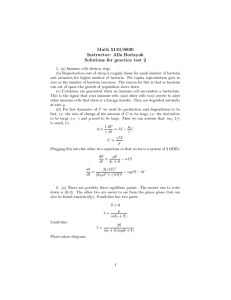Lab-Simple-HH-2014
advertisement
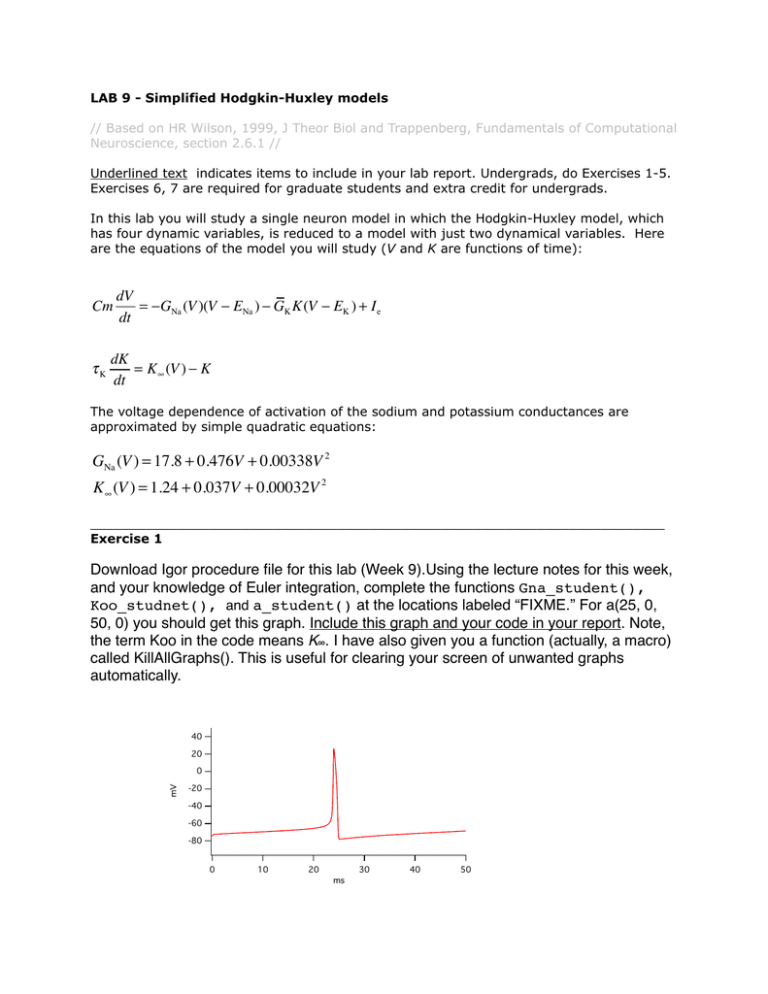
LAB 9 - Simplified Hodgkin-Huxley models ! ! ! // Based on HR Wilson, 1999, J Theor Biol and Trappenberg, Fundamentals of Computational Neuroscience, section 2.6.1 // Underlined text indicates items to include in your lab report. Undergrads, do Exercises 1-5. Exercises 6, 7 are required for graduate students and extra credit for undergrads. In this lab you will study a single neuron model in which the Hodgkin-Huxley model, which has four dynamic variables, is reduced to a model with just two dynamical variables. Here are the equations of the model you will study (V and K are functions of time): !! Cm dV = −GNa (V )(V − ENa ) − GK K(V − EK ) + I e dt ! τK ! ! dK = K ∞ (V ) − K dt The voltage dependence of activation of the sodium and potassium conductances are approximated by simple quadratic equations: ! GNa (V ) = 17.8 + 0.476V + 0.00338V 2 K ∞ (V ) = 1.24 + 0.037V + 0.00032V 2 ! ! ________________________________________________________________________ Exercise 1 Download Igor procedure file for this lab (Week 9).Using the lecture notes for this week, and your knowledge of Euler integration, complete the functions Gna_student(), Koo_studnet(), and a_student() at the locations labeled “FIXME.” For a(25, 0, 50, 0) you should get this graph. Include this graph and your code in your report. Note, the term Koo in the code means K∞. I have also given you a function (actually, a macro) called KillAllGraphs(). This is useful for clearing your screen of unwanted graphs automatically.! ! 40 20 mV 0 -20 -40 -60 -80 0 10 20 30 ms 40 50 ! ! ! ANSWER = the graph in your report ________________________________________________________________________ Exercise 2 ! Demonstrate that the resting potential of the neuron (-74.8 mV) is a stable condition. This is done by showing that V relaxes back to this value when perturbed away from it in either direction. To do this, you will run the program a( ) with Flag0 set to 1, which simulates the case in which V is moved to Vtest, held there until K reaches steady-state, then released. Explain how the program achieves this. ((ANSWER: V is initialized to Vtest and K is initialized to K_oo(Vtest). Good values of Vtest to try are Vtest+10, Vtest +5, Vtest, Vtest-5, Vtest-10. Save your program’s output into a distinct wave for each value of Vtest and superimpose them on a graph, which should look like the one below. Include this graph in your lab report.! ! ! ! ! ! ! -65 -70 mV -75 -80 -85 0 10 20 30 40 50 ms ANSWER = the graph in your report! ! ! ______________________________________________________________________ Exercise 3 ! ! Find threshold the threshold of your model neuron. To do this, you will perturb the membrane potential from the resting potential (Vo) to a range of depolarized values. ! This is done by set the the fourth argument (Flag0) in the function call to 2. Make sure you understand the effect on the if-statement elicited by this value of Flag0. Explain it in your report. (( Answer: At t = 50*dt, the membrane potential is jumped instantaneously to V = Vtest. )). Find the threshold by raising Vtest in small increments until you first see an action potential. You can do this by hand, or by embedding a() in a for-loop. Report your estimate of Vthreshold. ! ! ! ! Example function call: a(0, -30, 5, 2) 40 ! 20 mV 0 -20 -40 -60 -80 0 1 2 3 4 5 ms Answer. ! 0 Threshold (mV) = -39.5 mV -20 -40 -60 0 1 2 3 4 5 ms ! ! ! Red trace: a(0, -39.5, 5, 2). Gray trace a(0, -40, 5, 2).! ! ______________________________________________________________________! Exercise 4 Generate an F-I plot for the neuron. Measure spike frequency at the following values of Ie: 0, 10, 18.5, 18.7, 50, 100, 200, 250, 300, 340, 400, 500. Plot frequency vs. injected current on a log scale.! ! ! ! Example function call: a(100, 0, 200, 0) 40 ! 20 0 -20 mV !! ! ! ! ! ! ! ! ! ! ! ! ! -40 -60 -80 0 50 100 ms 150 200 Answer! Spike frequency (Hz) 400 300 200 100 0 10 2 3 4 5 6 7 8 9 100 Current (nA) 2 3 4 5 ! ! [2015]: Explain why the action potential fails to form when current is above 3 nA. This might involve analyzing the time course of the currents and/or conductances.! ____________________________________________________________________! Exercise 5 ! Analysis of ionic currents underlying the action potential. Uncomment and complete the four lines in the code marked “………..Ex_5”. Run your code with Vtest at the threshold value of the action potential: a(0, -39.8, 5, 2), and save the graph of the currents to you lab report. Now, run your code with Vtest ever so slightly below threshold and save the graph of the currents to you lab report. Inspect the relative values of INA and IK at i = 50. Use this information to define the threshold of the action potential in terms of the currents. Test your definition by trying a few more values of Vtest both above and below threshold.! ! ANSWER: To generate a response just below threshold,second graph a(0, -40, 5, 2). The threshold is the value of Vtest that causes the magnitude of the sodium current to exceed the magnitude of the potassium current.! ______________________________________________________________________! Exercise 6 ! Mathematical analysis of the model (Graduate students and extra credit). One of the reasons for reducing the 4-dimensional Hodgin-Huxley model to a 2-dimensional model is to make it more tractable to mathematical analysis. A common technique for analyzing 2-dimensional dynamical systems is phase-plane analysis.! ! The relevant phase plane for this system is K versus V. Dynamical analysis requires plotting the so-called “nullclines” in this plane. The V nullcline is the set of points (K, V) for which dV/dt = 0. Likewise, the K nullcline is the set of points for which dK/dt = 0. Derive expressions for the two nullclines.! ! Plot K nullcline on the phase plane, recalling that Kinf(V) = 1.24 + 0.037V + 0.0038V2). Plot the V nullcline for the case in which Ie = 0. Recall that GNa(V) = 17.8 + 0.476V + 0.00338V2, and that all the other terms in the correct solution for the V nullcline are constants whose value you have been given in the code. ! ! Your graph should look like this (include it in your lab report):! ! 1.0 V Nullcline K Nullcline 0.8 K 0.6 0.4 c a 0.2 b 0.0 -80 ! -60 -40 -20 V (mV/100) 0 20 40 ! At every point on the V nullcline, dV/dt = 0 by definition. Similarly, at every point on the K nullcline, dK/dt = 0. Thus, points a, b, and c are locations where both derivatives are zero. Such points called “fixed points” and they are dynamically significant – some are stable, others not, and these properties determine how the system moves from one location in the plane to the next. ! ! Using your phase-plane graph, estimate the (K, V) coordinates of points a, b and c. Select Graph > Show Info to place cursors on the curves. You can move these around with the arrow keys and the K and V values at each location are shown in a table below the graph.! ! A “stability analysis” investigates the dynamical properties of a system’s fixed points. You can perform an approximate stability analysis numerically by initializing V[0] and K[0] to the (V,K) coordinates of the point, and running the simulation for 50 sec. I’ve added an if-statement to help you do this (see //Excercise 6 only // in the code). Append to your phase-plane graph the trace K vs V. This shows the trajectory of the point in phase space as the system evolves, allowing you to see whether the system stay at or leaves this point. Do this for points a, b, c. Check your results by trying various points in the vicinity of these points. Indicate which point(s) are stable and where are unstable, and why.! ! [2015] Solve for the (V,K) coorindates of the fixed points. In the DEs for the system, set the derivative equal to zero and solve to two equations simultaneously. You should get a third order polynomial. Find the roots of that equation. ! ! ! ! ! ! ===! ! Answer! ! The V nullcline is obtained from the DE! ! Cm ! dV = −GNa (V )(V − ENa ) − GK K(V − EK ) + I e ! dt by setting dV/dt = 0 and solving for K. The K nullcline is obtained in an analogous way from! ! τK ! ! dK = K ∞ (V ) − K ! dt −GNa (V )(V − ENa ) + Ie GK (V − EK ) V nullcline K= K nullcline K = K ∞ (V ) ! ! Point a: (-74.7, 0.26), stable because trajectories approach and remain at a! Point b: (-59.6, 0.17), unstable because trajectories leave b and its vicinity! Point c: (-41.7, 0.253), unstable because trajectories leave c and its vicinity! ! ! ! ! ! ______________________________________________________________________! ! ! Exercise 7 Fixed point c is a special kind of fixed point called a “limit cycle attractor.” To see this behavior, inject enough current into the neuron to cause it to fire regularly. Replot the nullclines and notice that fixied points a and b no longer exist. Simulate the neuron under this amount of current injection for about 200 ms. Append K vs V to your graph of the nullclines. You should see something like this:! ! ! ! ! ! ! ! ! ! ! ! ! ! ! ! The gray line is cycles around point c, hence the term limit cycle.! ! 1.0 0.8 VNC KNC K vs V K 0.6 0.4 0.2 0.0 -80 -60 ANSWER = the graph in your report -40 -20 V (mV) 0 20 40
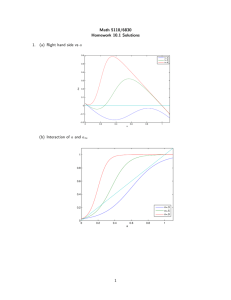
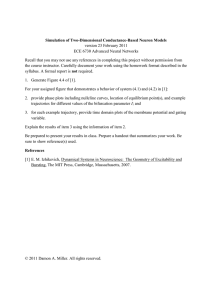

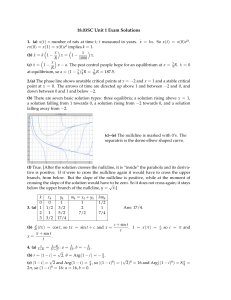
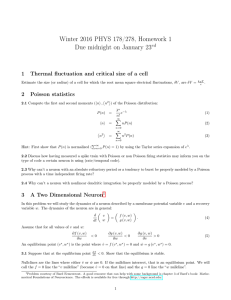
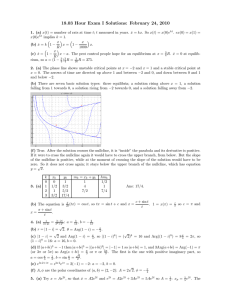
![PHYSICS 110A : CLASSICAL MECHANICS DISCUSSION #2 PROBLEMS [1] Solve the equation ...](http://s2.studylib.net/store/data/010997211_1-e584bd0bef85c1b26003f14bc9b84c94-300x300.png)
